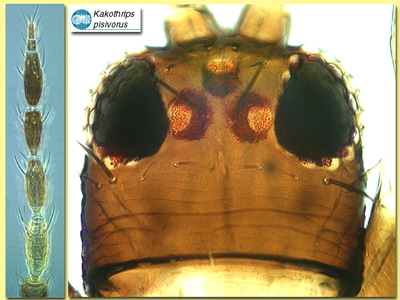Figures
Fig. 1 Antenna and head
Fig. 2 Fore and hind wing
Fig. 3 Pro-, meso- and metanotum
Fig. 4 Tergite VIII (female)
Species
Kakothrips pisivorus WestwoodBiology
Known as the pea thrips, this species breeds in the flowers of a few legumes including Pisum sativum and Vicia faba, and periodically is a pest on these crops.
Distribution
Europe.
Recognition
Body and legs dark brown, tarsi and antennal segment III almost yellow; fore wing brown but paler at base. Head with 3 pairs of ocellar setae, pair III long and arising between posterior ocelli; one pair of postocular setae long. Pronotum with 5 pairs of long major setae, anteromarginals much shorter than anteroangulars, without a pair of minor setae between the posteromarginal setae. Metanotal median setae long and close to anterior margin; campaniform sensilla present. Forewing with 2 complete rows of setae. Fore tarsus with a small tooth apically. Tergites V-VI with no ctenidia, VII with a very poorly developed pair, VIII with ctenidia weakly developed anterolateral to spiracle; VIII with posteromarginal comb of slender microtrichia arising from triangular bases. Male with large paired tubercles in front of spiracles on tergite VIII; glandular area present on sternites III-VII.
Related species
The genus Kakothrips is used for a group of European species that are closely related to members of Frankliniella. They differ in having no ctenidia on abdominal tergites V & VI, and in lacking a pair of setae between the major pronotal posteromarginal setae. This species is also known as Kakothrips robustus Uzel.





